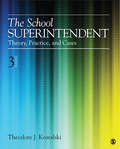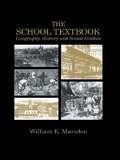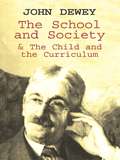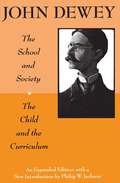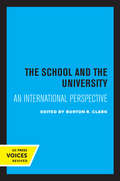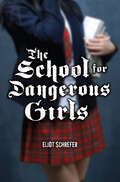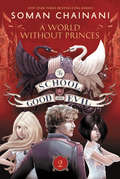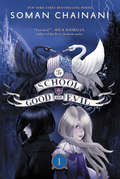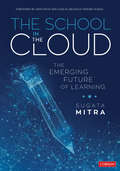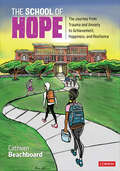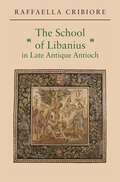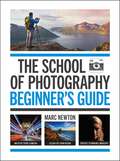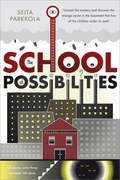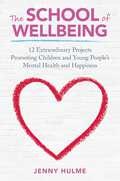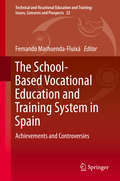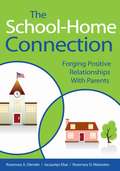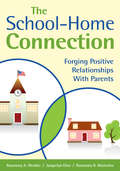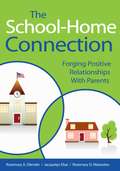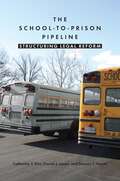- Table View
- List View
The School Superintendent: Theory, Practice, and Cases
by Theodore J. KowalskiThe School Superintendent: Theory, Practice, and Cases is the essential guide to succeeding as a superintendent or as an administrator in another district-level position. Comprehensive in both theory and practice, this textbook and reference guide examines the role and responsibilities of school district administration in professional, social, philosophical, and political frames, while balancing perspectives of rewards and challenges commonly expressed by school superintendents. Important topics covered include the emerging role of superintendent as communicator, the changing conditions in districts and schools, inadequate funding for public schools, and the treatment of policy administration, leadership roles, and community involvement.Fully updated, the Third Edition provides: greater emphasis on the challenges facing novice superintendents; new material on strategic planning and visioning; new and expanded coverage of contemporary issues such as inadequate district funding and social challenges; additional figures, tables, key terms, and other helpful learning tools; and more.
The School Textbook: History, Geography and Social Studies
by William E. MarsdenA study of the school textbook grounded in historical and comparative perspectives. The approach is broadly chronological, revealing changes in the theory and practice of textbook production and use. The book focuses largely on three associated subjects - geography, history and social studies.
The School and Society & The Child and the Curriculum (Centennial Publications Of The University Of Chicago Press Ser.)
by John DeweyOne of the most influential forces in the shaping of American education, the famed philosopher and psychologist John Dewey (1859–1952) believed in "viewing the education of the child in the light of the principles of mental activity and processes of growth made know by modern psychology." As the administrator of the University of Chicago's laboratory school — which he established in 1896 and which was one of the first such schools in the United States — Dewey came to the realization that learning was a process starting from uncertainty and growing from the impulse which must begin with experience, and the curriculum must be made to relate to the students' interests.The two books in this volume — both short, but extremely influential — grew out of Dewey's hands-on experience with the laboratory school and represent the earliest authoritative statement of his revolutionary emphasis on education as an experimental, child-centered process, In The School and Society, he declares that we must "make each one of our schools an embryonic community life, active with types of occupations that reflect the life of the larger society and permeated with the spirit of art, history, and science." In The Child and the Curriculum, he stresses the importance of the curriculum as a means of determining the environment of the child, and allowing the teacher to guide children in asserting themselves, exercising their capacities, and fulfilling the destinies of their own nature.Gathered in this single convenient volume, these thought-provoking contributions by one of America's greatest thinkers in the field of pedagogy will be immense interest to educators, psychologists, parents, and anyone interested in the psychology and philosophy of childhood education.
The School and Society and The Child and the Curriculum (Centennial Publications Of The University Of Chicago Press Ser.)
by John DeweyThis edition brings Dewey's educational theory into sharp focus, framing his two classic works by frank assessments, past and present, of the practical applications of Dewey's ideas. In addition to a substantial introduction in which Philip W. Jackson explains why more of Dewey's ideas haven't been put into practice, this edition restores a "lost" chapter, dropped from the book by Dewey in 1915.
The School and Society, and The Child and the Curriculum
by John DeweyAmerica's arch-philosopher of education wrote these two short pieces out of his experience with Chicago's laboratory school which he started in 1896. Dewey's first piece (1915) argues for making the school into a microsociety of the larger one, while in the second (1902) he seeks a curriculum acting as a kind of program for teachers to follow. Teachers can then guide children toward enough self-confidence to be assertive and exercise their capacities. Cited in Books for College Libraries, 3rd ed. Annotation c. Book News, Inc., Portland, OR (booknews.com)
The School and the University: An International Perspective
by Burton R. ClarkThis title is part of UC Press's Voices Revived program, which commemorates University of California Press’s mission to seek out and cultivate the brightest minds and give them voice, reach, and impact. Drawing on a backlist dating to 1893, Voices Revived makes high-quality, peer-reviewed scholarship accessible once again using print-on-demand technology. This title was originally published in 1985.
The School for Dangerous Girls
by Eliot Schrefer“This psychological thriller follows a girl with dark secrets to a school with uneasy mysteries of its own . . . Gripping, violent and terrifying.” —Kirkus ReviewsA New York Public Library “Best of the Teen Age”Angela’s parents think she’s on the road to ruin because she’s dating a “bad boy.” After her behavior gets too much for them, they ship her off to Hidden Oak. Isolated and isolating, Hidden Oak promises to rehabilitate “dangerous girls.” But as Angela gets drawn in further and further, she discovers that recovery is only on the agenda for the “better” girls. The other girls—designated as “the purple thread” —will instead be manipulated to become more and more dangerous . . . and more and more reliant on Hidden Oak’s care.“Teens might behave dangerously themselves to get their hands on this page-turner with its commentary on education.” —Booklist“The struggle and eventual triumph of the bad girls over the evil teachers makes for an intriguing conflict that many teens will appreciate.” —School Library Journal“Compelling and page-turning . . . For any fan of gothic, dark, gripping action, The School for Dangerous Girls should not be missed.” —TeensReadToo.com
The School for Good and Evil #2: Now a Netflix Originals Movie (School for Good and Evil #2)
by Soman ChainaniTHE SCHOOL FOR GOOD AND EVIL will soon be a major motion picture from Netflix—starring Academy Award winner Charlize Theron, Kerry Washington, Laurence Fishburne, Michelle Yeoh, Sofia Wylie, Sophie Anne Caruso, Jamie Flatters, Earl Cave, Kit Young, and more! In the New York Times bestselling sequel to Soman Chainani's debut, The School for Good and Evil, Sophie and Agatha are back in Gavaldon, living out their Happily Ever After, but life isn't quite the fairy tale they expected. Witches and princesses reside at the School for Girls, where they've been inspired to live a life without princes, while Tedros and the boys are camping in Evil's old towers. A war is brewing between the schools, but can Agatha and Sophie restore the peace? Can Sophie stay good with Tedros on the hunt? And whose heart does Agatha's belong to—her best friend or her prince?Soman Chainani has created a spectacular world that Newbery Medal-winning author Ann M. Martin calls "a fairy tale like no other, complete with romance, magic, humor, and a riddle that will keep you turning pages until the end."Don't miss the thrilling conclusion to the beloved series, The School for Good and Evil #6: One True King!
The School for Good and Evil: Now a Netflix Originals Movie (School for Good and Evil #1)
by Soman ChainaniTHE SCHOOL FOR GOOD AND EVIL will soon be a major motion picture from Netflix—starring Academy Award winner Charlize Theron, Kerry Washington, Laurence Fishburne, Michelle Yeoh, Sofia Wylie, Sophie Anne Caruso, Jamie Flatters, Earl Cave, Kit Young, and more! The New York Times bestselling School for Good and Evil series is an epic journey into a dazzling new world, where the only way out of a fairy tale is to live through one. Start here to follow Sophie, Agatha, and everyone at school from the beginning!With her glass slippers and devotion to good deeds, Sophie knows she'll earn top marks at the School for Good and join the ranks of past students like Cinderella, Rapunzel, and Snow White. Meanwhile, Agatha, with her shapeless black frocks and wicked black cat, seems a natural fit for the villains in the School for Evil.The two girls soon find their fortunes reversed—Sophie's dumped in the School for Evil to take Uglification, Death Curses, and Henchmen Training, while Agatha finds herself in the School for Good, thrust among handsome princes and fair maidens for classes in Princess Etiquette and Animal Communication.But what if the mistake is actually the first clue to discovering who Sophie and Agatha really are?Don't miss the thrilling conclusion to the beloved series, The School for Good and Evil #6: One True King!
The School in the Bush: A Critical Study Of The Theory And Practice Of Native Education In Africa (Routledge Revivals)
by A. Victor MurrayPublished in 1967: The School in the Bush is about Missionary Education in British territories in Africa.
The School in the Cloud: The Emerging Future of Learning (Corwin Teaching Essentials)
by Sugata MitraThe Science and the Story of the Future of Learning Educators have been trying to harness the "promise" of technology in education for decades, to no avail, but we have learned that children in groups—when given access to the Internet—can learn anything by themselves. In this groundbreaking book, you’ll glimpse the emerging future of learning with technology. It turns out the promise isn’t in the technology itself; it’s in the self-directed learning of the children who use it. In 1999, Sugata Mitra conducted the famous "Hole in the Wall" experiment that inspired three TED Talks and earned him the first million-dollar TED prize for research in 2013. Since then, he has conducted new research around self-organized learning environments (SOLE), building "Schools in the Cloud" all over the world. This new book shares the results of this research and offers • Examples of thriving Schools in the Cloud in unlikely places • Mitra’s predictions on the future of learning • How to design assessments for self-organizing learning • How to build your own School in the Cloud • Clips from the documentary, The School in the Cloud Discover the future of learning by digging deep into Mitra’s thought-provoking experiences, examples, and vision.
The School in the Cloud: The Emerging Future of Learning (Corwin Teaching Essentials)
by Sugata MitraThe Science and the Story of the Future of Learning Educators have been trying to harness the "promise" of technology in education for decades, to no avail, but we have learned that children in groups—when given access to the Internet—can learn anything by themselves. In this groundbreaking book, you’ll glimpse the emerging future of learning with technology. It turns out the promise isn’t in the technology itself; it’s in the self-directed learning of the children who use it. In 1999, Sugata Mitra conducted the famous "Hole in the Wall" experiment that inspired three TED Talks and earned him the first million-dollar TED prize for research in 2013. Since then, he has conducted new research around self-organized learning environments (SOLE), building "Schools in the Cloud" all over the world. This new book shares the results of this research and offers • Examples of thriving Schools in the Cloud in unlikely places • Mitra’s predictions on the future of learning • How to design assessments for self-organizing learning • How to build your own School in the Cloud • Clips from the documentary, The School in the Cloud Discover the future of learning by digging deep into Mitra’s thought-provoking experiences, examples, and vision.
The School of Hope: The Journey From Trauma and Anxiety to Achievement, Happiness, and Resilience
by Cathleen BeachboardDiscover how to improve achievement, happiness, and resilience using the science of hope The current mental health crisis is driving many teachers to leave the profession while students struggle with engagement and anxiety. Trauma-informed coping mechanisms are helpful, but this book goes a step further by incorporating much-needed but often-missing support to help learners feel hopeful and provide educators with resources to care for themselves. Based on research around the psychological science of hope, this guidebook provides strategies educators and school leaders can use daily to help students feel secure, build relationships, and improve academic outcomes. Included are practices and interventions that can be woven into classrooms and schools to foster mental wellness and happiness using Classroom materials, tools, and reproducibles Scientific resources to quickly assess and monitor hope Simple plans of action to improve hope, engagement, and motivation Vignettes from classrooms and the author’s own experiences with children who have experienced extreme trauma Backed by the latest research, The School of Hope will encourage higher academic attainment and equity, inspiring a sense of deeper fulfillment for both students and educators.
The School of Hope: The Journey From Trauma and Anxiety to Achievement, Happiness, and Resilience
by Cathleen BeachboardDiscover how to improve achievement, happiness, and resilience using the science of hope The current mental health crisis is driving many teachers to leave the profession while students struggle with engagement and anxiety. Trauma-informed coping mechanisms are helpful, but this book goes a step further by incorporating much-needed but often-missing support to help learners feel hopeful and provide educators with resources to care for themselves. Based on research around the psychological science of hope, this guidebook provides strategies educators and school leaders can use daily to help students feel secure, build relationships, and improve academic outcomes. Included are practices and interventions that can be woven into classrooms and schools to foster mental wellness and happiness using Classroom materials, tools, and reproducibles Scientific resources to quickly assess and monitor hope Simple plans of action to improve hope, engagement, and motivation Vignettes from classrooms and the author’s own experiences with children who have experienced extreme trauma Backed by the latest research, The School of Hope will encourage higher academic attainment and equity, inspiring a sense of deeper fulfillment for both students and educators.
The School of Libanius in Late Antique Antioch
by Raffaella CribioreThis book is a study of the fourth-century sophist Libanius, a major intellectual figure who ran one of the most prestigious schools of rhetoric in the later Roman Empire. He was a tenacious adherent of pagan religion and a friend of the emperor Julian, but also taught leaders of the early Christian church like St. John Chrysostom and St. Basil the Great. Raffaella Cribiore examines Libanius's training and personality, showing him to be a vibrant educator, though somewhat gloomy and anxious by nature. She traces how he cultivated a wide network of friends and former pupils and courted powerful officials to recruit top students. Cribiore describes his school in Antioch--how students applied, how they were evaluated and trained, and how Libanius reported progress to their families. She details the professional opportunities that a thorough training in rhetoric opened up for young men of the day. Also included here are translations of 200 of Libanius's most important letters on education, almost none of which have appeared in English before. Cribiore casts into striking relief the importance of rhetoric in late antiquity and its influence not only on pagan intellectuals but also on prominent Christian figures. She gives a balanced view of Libanius and his circle against the far-flung panorama of the Greek East.
The School of Oriental and African Studies
by Ian BrownThe School of Oriental and African Studies, a college of the University of London, was established in 1916 principally to train the colonial administrators who ran the British Empire in the languages of Asia and Africa. It was founded, that is, with an explicitly imperial purpose. Yet the School would come to transcend this function to become a world centre of scholarship and learning, in many important ways challenging that imperial origin. Drawing on the School's own extensive administrative records, on interviews with current and past staff, and on the records of government departments, Ian Brown explores the work of the School over its first century. He considers the expansion in the School's configuration of studies from the initial focus on languages, its changing relationships with government, and the major contributions that have been made by the School to scholarly and public understandings of Asia, Africa, and the Middle East.
The School of Photography: Beginner's Guide
by Marc NewtonThe School of Photography: Beginner's Guide will take the beginner photographer to an advanced level in no time and fill any gaps in photography knowledge that may be holding you back from reaching your full potential. You'll be able to use your camera confidently in all the manual modes and apply the knowledge gained to any situation. The book will make you feel completely confident and ensure your shots stack up against any professional-looking photography.It's for people who want to take photography more seriously and will suit beginners, keen enthusiasts or anyone looking to make photography their profession. This book will put an end to any confusion, while giving you accurate and thorough knowledge in photography.Topics covered include:- Camera kits and equipment- Working in manual settings- Composition- Apertures and depth of field- Shutter speeds- Night photography
The School of Photography: Beginner's Guide
by Marc NewtonThe School of Photography: Beginner's Guide will take the beginner photographer to an advanced level in no time and fill any gaps in photography knowledge that may be holding you back from reaching your full potential. You'll be able to use your camera confidently in all the manual modes and apply the knowledge gained to any situation. The book will make you feel completely confident and ensure your shots stack up against any professional-looking photography.It's for people who want to take photography more seriously and will suit beginners, keen enthusiasts or anyone looking to make photography their profession. This book will put an end to any confusion, while giving you accurate and thorough knowledge in photography.Topics covered include:- Camera kits and equipment- Working in manual settings- Composition- Apertures and depth of field- Shutter speeds- Night photography
The School of Possibilities
by Seita ParkkolaStorm Steele is an impossible child. Or so his parents believe thanks to the influence of his evil "step-monster." Now Storm is being forced to attend the School of Possibilities for troubled youth. But Storm notices that something strange is going on at his new school. The students are not. . . normal. Soon he's being spied on, followed by classmates-and worst of all, forced to accept the headmaster's perfectly behaved daughter as his girlfriend. He can feel himself becoming more obedient, more like his classmates. Storm tries to resist, but he doesn't understand how or why the school is controlling him. Can Storm escape-or will he be turned into a zombie of "good" behavior like everyone else around him?
The School of Wellbeing: 12 Extraordinary Projects Promoting Children and Young People's Mental Health and Happiness
by Jenny Hulme Jane Asher Jane Powell Asad Ahmad Gok Wan Kate Griggs Nicky Cox Professor Tanya Byron Rebecca Root Suzy GreavesAs rates of depression, anxiety, self-harm and eating disorders are on the up among young people, how can schools provide appropriate information and support for the young people in their classrooms? How can they bridge the gap between what they know matters - the impact of these issues on learning and life-long health - and the mounting day-to-day priorities and pressures of school life? This book provides unique insight into 12 projects that are helping to answer these questions and supporting teachers to make mental health and emotional wellbeing a key player in the school day. With a mix of longer-term initiatives and simple strategies that schools can put in place immediately, it explores mentoring and mindfulness, social action and sport, Lego play and poetry, the power of parents and the role of PSHE. It describes how these projects work practically and shares the impact they are having, increasing resilience and raising the aspirations and emotional wellbeing of the whole school community. As well as showcasing ideas that are making a difference, the book meets with the education leaders and charities behind the initiatives (including Place2Be, Step up to Serve, Kidscape, Mosaic, Diversity Role Models, Beat, Achievement for All and others) who offer advice and signpost useful information to support readers in getting these ideas off the ground in their schools. This book is a source of inspiration for headteachers, senior leadership teams, pastoral care teams, school counsellors and psychologists.
The School-Based Vocational Education and Training System in Spain: Achievements and Controversies (Technical and Vocational Education and Training: Issues, Concerns and Prospects #32)
by Fernando Marhuenda-FluixáThis book discusses the developments in policy and practice in the field of formal, non-formal and continuing vocational education and training in Spain since 1970. It describes how VET has been transformed and become one of the country’s main areas of pedagogical innovation, and also examines current developments, such as the role of non-formal vocational education and training, the accreditation of vocational qualifications acquired in the non-formal system, and the adoption of dual apprenticeships that bear little resemblance to central European dual systems.Written by respected researchers in these fields, the first section is informative and analytical, offering a description of the system and comments based on academic literature and research. The second section illustrates the research on relevant issues, portraying empirical data from different regions in Spain, as well as nationwide data. Explaining and interpreting data on the basis of the authors’ different theoretical frameworks, the book provides a comprehensive, updated and accurate overview of VET and relevant research in Spain, as well as their relation to European and global developments.
The School-Home Connection
by Rosemary A. Olender Jacquelyn Elias Rosemary D. MastroleoResearch has consistently shown that student success is directly related to the strength of the relationships between parents and schools. In The School-Home Connection, the authors draw on original research and their professional experiences to identify the common sources of both negative and positive school-home relationships. The book presents a comprehensive approach to building closer connections and includes:Tools to help educators develop a deeper understanding of the communities they serveStrategies for improving interpersonal skills and communication skillsA chapter on the importance of documenting and celebrating school eventsGuidelines for creating three distinct levels of parental participation in schoolsWith suggestions for cultivating a community network of support services and a summary of lessons for forging constructive relationships, The School-Home Connection is an essential tool for educators looking to strengthen the learning community and increase student achievement.
The School-Home Connection: Forging Positive Relationships With Parents
by Rosemary A. Olender Jacquelyn Elias Rosemary D. MastroleoDrawing on original research and the authors' professional experiences, this resource presents a comprehensive approach to developing more positive relationships with students and their families.
The School-Home Connection: Forging Positive Relationships with Parents
by Rosemary A. Olender Jacquelyn Elias Rosemary D. MastroleoResearch has consistently shown that student success is directly related to the strength of the relationships between parents and schools. In The School-Home Connection, the authors draw on original research and their professional experiences to identify the common sources of both negative and positive school-home relationships. The book presents a comprehensive approach to building closer connections and includes:Tools to help educators develop a deeper understanding of the communities they serveStrategies for improving interpersonal skills and communication skillsA chapter on the importance of documenting and celebrating school eventsGuidelines for creating three distinct levels of parental participation in schoolsWith suggestions for cultivating a community network of support services and a summary of lessons for forging constructive relationships, The School-Home Connection is an essential tool for educators looking to strengthen the learning community and increase student achievement.
The School-to-Prison Pipeline: Structuring Legal Reform
by Catherine Y. Kim Daniel J. Losen Damon T. HewittAn in-depth analysis of the legal entry points and remedies in the school-to-prison pipelineThe “school-to-prison pipeline” is an emerging trend that pushes large numbers of at-risk youth—particularly children of color—out of classrooms and into the juvenile justice system. The policies and practices that contribute to this trend can be seen as a pipeline with many entry points, from under-resourced K-12 public schools, to the over-use of zero-tolerance suspensions and expulsions and to the explosion of policing and arrests in public schools. The confluence of these practices threatens to prepare an entire generation of children for a future of incarceration.In this comprehensive study of the relationship between American law and the school-to-prison pipeline, co-authors Catherine Y. Kim, Daniel J. Losen, and Damon T. Hewitt analyze the current state of the law for each entry point on the pipeline and propose legal theories and remedies to challenge them. Using specific state-based examples and case studies, the authors assert that law can be an effective weapon in the struggle to reduce the number of children caught in the pipeline, address the devastating consequences of the pipeline on families and communities, and ensure that our public schools and juvenile justice system further the goals for which they were created: to provide meaningful, safe opportunities for all the nation’s children.
